Design and Properties of Coal Gangue-Based Geopolymer Mortar
Abstract
:1. Introduction
2. Experimental Section
2.1. Raw Materials
2.2. Mixture Proportions
2.3. Experimental Methods
2.3.1. Fluidity Test
2.3.2. Mechanical Test
2.3.3. Drying Shrinkage Test
3. Results and Discussion
3.1. Fluidity
3.2. Mechanical Properties
3.2.1. Flexural and Compressive Strength
3.2.2. Relative Strength
3.2.3. Influence of the fcf/fcu Ratio
3.3. One-Way Analysis of Variance (ANOVA)
3.3.1. Significant Analysis of the Impact Factors for Flexural Strength
3.3.2. Significant Analysis of the Impact Factors for Compressive Strength
3.4. Microstructure Analysis
3.5. Drying Shrinkage
4. Conclusions
- (1)
- Compared with the OPCM, the CGBGM has higher compressive strength, flexural strength, and early strength. The flexural and compressive strength of the W/B0.50 group increased by 42.13% and 22.60%, respectively. The flexural and compressive strength of the CGBGM rapidly increases before 7 d and then tends to slow afterward. In addition, the fcf/fcu ratio gradually declined as the curing time developed.
- (2)
- According to the impact degree on the mechanical properties of the CGBGM, the A is ranked first, followed by the W/B, and finally the S. The slag can dramatically enhance the mechanical properties of the CGBGM. The flexural and compressive strength of specimens with 40% slag increased by 45.97% and 90.75%, respectively, compared to the control group. However, the A and W/B have little effect on flexural strength.
- (3)
- With the increase in curing ages, the hydration productions filled in the crevice and healed the entrapped microcracks in the hardened paste, forming a dense microstructure. In addition, the calcium-to-silicon ratio (Ca/Si) decreased from 0.5 at 3 d to 0.06 at 28 d, and the calcium-to-aluminum ratio (Ca/Al) decreased from 0.25 at 3 d to 0.05 at 28 d.
- (4)
- Compared with the OPCM, the mass-loss rate and drying shrinkage of the CGBGM were greater than those of the OPCM. The mass-loss rate and drying shrinkage of the CGBGM at 180 d increased by 95.20% and 78.08%, respectively. Additionally, the drying shrinkage behavior curve of the CGBGM includes three stages: rapid increase, slow increase, and stabilization.
Author Contributions
Funding
Institutional Review Board Statement
Informed Consent Statement
Data Availability Statement
Conflicts of Interest
References
- Li, Y.; Yao, Y.; Liu, X.M.; Sun, H.H.; Ni, W. Improvement on pozzolanic reactivity of coal gangue by integrated thermal and chemical activation. Fuel 2013, 109, 527–533. [Google Scholar] [CrossRef]
- Peng, B.; Li, X.; Zhao, W.; Yang, L. Study on the release characteristics of chlorine in coal gangue under leaching conditions of different pH values. Fuel 2018, 217, 427–433. [Google Scholar] [CrossRef]
- Kasassi, A.; Rakimbei, P.; Karagiannidis, A.; Zabaniotou, A.; Tsiouvaras, K.; Nastis, A.; Tzafeiropoulou, K. Soil contamination by heavy metals: Measurements from a closed unlined landfill. Bioresour. Technol. 2008, 99, 8578–8584. [Google Scholar] [CrossRef] [PubMed]
- Li, J.Y.; Wang, J.M. Comprehensive utilization and environmental risks of coal gangue: A review. J. Clean. Prod. 2019, 239, 117946. [Google Scholar] [CrossRef]
- Jabłońska, B.; Kityk, A.V.; Busch, M.; Huber, P. The structural and surface properties of natural and modified coal gangue. J. Environ. Manag. 2017, 190, 80–90. [Google Scholar] [CrossRef]
- Li, M.; Zhang, J.x.; Li, A.l.; Zhou, N. Reutilisation of coal gangue and fly ash as underground backfill materials for surface subsidence control. J. Clean. Prod. 2020, 254, 120113. [Google Scholar] [CrossRef]
- Liu, H.; Xu, Q.; Wang, Q.; Zhang, Y. Prediction of the elastic modulus of concrete with spontaneous-combustion and rock coal gangue aggregates. Structures 2020, 28, 774–785. [Google Scholar] [CrossRef]
- Zhao, Y.; Yang, C.; Cheng, S.; Wu, Z.; Wang, B. Performance and Hydration Mechanism of Modified Tabia with Composite-Activated Coal Gangue. Crystals 2022, 12, 150. [Google Scholar] [CrossRef]
- Rybak, S.M.G.J.; Bujanovna-Syuryun, K.C.; Khairutdinov, A.M.; Tyulyaeva, Y.S.; Makarov, P.S. Utilization of Mineral Waste: A Method for Expanding the Mineral Resource Base of a Mining and Smelting Company. Metallurgist 2021, 64, 851–861. [Google Scholar] [CrossRef]
- Ivannikov, A.L.; Kongar-Syuryun, C.; Rybak, J.; Tyulyaeva, Y. The reuse of mining and construction waste for backfill as one of the sustainable activities. IOP Conf. Ser. Earth Environ. Sci. 2019, 362, 012130. [Google Scholar] [CrossRef]
- Rybak, J.; Kongar-Syuryun, C.; Tyulyaeva, Y.; Khayrutdinov, A.M. Creation of backfill materials based on industrial waste. Minerals 2021, 11, 739. [Google Scholar] [CrossRef]
- Frías, M.; Rojas, M.; García, R.; Valdés, A.; Medina, C. Effect of activated coal mining wastes on the properties of blended cement. Cem. Concr. Comp. 2012, 34, 678–683. [Google Scholar] [CrossRef]
- Yang, J.B.; Fang, Y.; Li, D.S. Hydration Products C-A-S-H and N-A-S-H of Alkali-activated Materials. Bull. Chin. Ceram. Soc. 2017, 36, 3292–3297+3310. [Google Scholar]
- Thomas, R.J.; Ye, H.; Radlinska, A.; Peethamparan, S. Alkali-Activated Slag Cement Concrete. Concr. Int. 2016, 38, 33–38. [Google Scholar]
- Duxson, P.; Provis, J.L.; Lukey, G.C.; Deventer, J. The role of inorganic polymer technology in the development of ‘green concrete’. Cem. Concr. Res. 2007, 37, 1590–1597. [Google Scholar] [CrossRef]
- Ma, H.; Zhu, H.; Wu, C.; Chen, H.; Liu, J. Study on compressive strength and durability of alkali-activated coal gangue-slag concrete and its mechanism. Powder Technol. 2020, 368, 112–124. [Google Scholar] [CrossRef]
- Zhu, H.; Yang, S.; Li, W.; Li, Z.; Shen, Z. Study of Mechanical Properties and Durability of Alkali-Activated Coal Gangue-Slag Concrete. Materials 2020, 13, 5576. [Google Scholar] [CrossRef]
- Cheng, Y.; Ma, H.; Chen, H.; Wang, J.; Jing, S.; Li, Z.; Yu, M. Preparation and characterization of coal gangue geopolymers. Constr. Build. Mater. 2018, 187, 318–326. [Google Scholar] [CrossRef]
- Zhang, Y.; Ling, T.C. Reactivity activation of waste coal gangue and its impact on the properties of cement-based materials—A review. Constr. Build. Mater. 2020, 234, 117424. [Google Scholar] [CrossRef]
- Zhao, Y.; Yang, C.; Li, K.; Qu, F.; Yan, C.; Wu, Z. Toward understanding the activation and hydration mechanisms of composite activated coal gangue geopolymer. Constr. Build. Mater. 2022, 318, 125999. [Google Scholar] [CrossRef]
- Ma, H.; Chen, H.; Zhu, H.; Shi, Y.; Hang, Z. Study on the drying shrinkage of alkali-activated coal gangue-slag mortar and its mechanisms. Constr. Build. Mater. 2019, 225, 204–213. [Google Scholar]
- Ye, H.; Aleksandra, R. A Review and Comparative Study of Existing Shrinkage Prediction Models for Portland and Non-Portland Cementitious Materials. Adv. Mater. Sci. Eng. 2016, 2016, 2418219. [Google Scholar] [CrossRef] [Green Version]
- Zhou, M.; Wang, Z.S. Analysis of Coal Gangue Used to Produce Green Materials. Sci. Technol. Eng. 2007, 7, 1443–1445. [Google Scholar]
- Frías, M.; Villa, R.; Rojas, M.; Medina, C.; Valdés, A.; Jantzen, C. Scientific Aspects of Kaolinite Based Coal Mining Wastes in Pozzolan/Ca(OH)2 System. J. Am. Ceram. Soc. 2012, 95, 386–391. [Google Scholar] [CrossRef]
- Frasson, B.J.; Pinto, R.C.A.; Rocha, J.C. Influence of different sources of coal gangue used as aluminosilicate powder on the mechanical properties and microstructure of alkali-activated cement. Mater. Constr. 2019, 69, 199. [Google Scholar] [CrossRef] [Green Version]
- Lu, P.W. Foundation of Inorganic Materials Science; Wuhan Gong Ye Da Xue Chu Ban She: Wuhan, China, 1996. [Google Scholar]
- Li, D.X.; Chen, Y.M.; Shen, J.L.; Su, J.H.; Wu, X.Q. The influence of alkalinity on activation and microstructure of fly ash. Cem. Concr. Res. 2000, 30, 881–886. [Google Scholar] [CrossRef]
- Zhang, C.S.; Xue, J.P.; Fang, L.M. Mechanical properties and microstructures of alkali activated burned coal gangue cementitious material. J. China Ceram. Soc. 2004, 32, 1276–1280. [Google Scholar]
- Adam, M.J.M.H.; Ajalloeian, R.; Hajiannia, A. Preparation and application of alkali-activated materials based on waste glass and coal gangue: A review. Constr. Build. Mater. 2019, 221, 84–98. [Google Scholar]
- ACI Committee. Building Code Requirements for Structural Concrete: (ACI 318-02) and Commentary (ACI 318R-02); American Concrete Institute: Farmington Hills, MI, USA, 2002. [Google Scholar]
- JGJ70-90; Standard for Test Method of Perormance on Building Mortar. China Architecture & Building Press: Beijing, China, 2009.
- Zheng, W.P.; Zhou, M.N.; Wang, Y. Literature review of alkali-activated cementitious materials. J. Build. Struct. 2018, 40, 28–39. [Google Scholar]
- Zheng, D.P.; Wang, D.M.; Tang, G.B.; Duan-Le, L.I.; Lin, H. Research on Water Repuirement of Gangue-cement Composites. Bull. Chin. Ceram. Soc. 2015, 34, 340–344. [Google Scholar]
- Wang, Q.; Kang, R.S.; Wu, L.M.; Tang, N.; Zhang, Q. Molecular simulation of N-A-S-H and C-A-S-H in geopolymer cementitious system. J. Bulid. Mater. 2020, 23, 8. [Google Scholar]
- Zhang, B.; Zhu, H.; Shah, K.W.; Dong, Z.; Wu, J. Performance evaluation and microstructure characterization of seawater and coral/sea sand alkali-activated mortars. Constr. Build. Mater. 2020, 259, 120403. [Google Scholar] [CrossRef]
- Li, K.; Wei, Z.; Qiaou, H.; Lu, C.; Theogene, H. PCM-Concrete Interfacial Tensile Behavior Using Nano-SiO2 Based on Splitting-Tensile Test. J. Adv. Concr. Technol. 2021, 19, 321–334. [Google Scholar] [CrossRef]
- Mastali, M.; Kinnunen, P.; Dalvand, A.; Firouz, R.M.; Illikainen, M. Drying shrinkage in alkali-activated binders—A critical review. Constr. Build. Mater. 2018, 190, 533–550. [Google Scholar] [CrossRef]
- Matalkah, F.; Salem, T.; Shaafaey, M.; Soroushian, P. Drying shrinkage of alkali activated binders cured at room temperature. Constr. Build. Mater. 2019, 201, 563–570. [Google Scholar] [CrossRef]
- Lee, K.N.; Jang, G.J.; Lee, K.H. Shrinkage characteristics of alkali-activated fly ash/slag paste and mortar at early ages. Cem. Concr. Comp. 2014, 53, 239–248. [Google Scholar] [CrossRef]
- Collins, F.; Sanjayan, J.G. Microcracking and strength development of alkali activated slag concrete. Cem. Concr. Comp. 2001, 23, 345–352. [Google Scholar] [CrossRef]
- Wang, L.; Huang, Y.; Zhao, F.; Huo, T.; Chen, E.; Tang, S. Comparison between the Influence of Finely Ground Phosphorous Slag and Fly Ash on Frost Resistance, Pore Structures and Fractal Features of Hydraulic Concrete. Fractal Fract. 2022, 6, 598. [Google Scholar] [CrossRef]
- Wang, L.; Yu, Z.; Liu, B.; Zhao, F.; Tang, S.; Jin, M. Effects of fly ash dosage on shrinkage, crack resistance and fractal characteristics of face slab concrete. Fractal Fract. 2022, 6, 335. [Google Scholar] [CrossRef]
- Wang, L.; Li, G.; Li, X.; Guo, F.; Tang, S.; Lu, X.; Hanif, A. Influence of reactivity and dosage of MgO expansive agent on shrinkage and crack resistance of face slab concrete. Cem. Concr. Comp. 2022, 126, 104333. [Google Scholar] [CrossRef]
- Ma, H.; Zhu, H.; Wu, C.; Fan, J.; Yang, S.; Hang, Z. Effect of shrinkage reducing admixture on drying shrinkage and durability of alkali-activated coal gangue-slag material. Constr. Build. Mater. 2021, 270, 121372. [Google Scholar] [CrossRef]
- Zhang, B.; Zhu, H.; Feng, P.; Zhang, P. A review on shrinkage-reducing methods and mechanisms of alkali-activated/geopolymer systems: Effects of chemical additives. J. Build. Eng. 2022, 49, 104056. [Google Scholar] [CrossRef]
- Nguyen, C.V.; Mangat, P.S.; Jones, G. Effect of Shrinkage Reducing Admixture on the Strength and Shrinkage of Alkali Activated Cementitious Mortar. IOP Conf. Ser. Mater. Sci. Eng. 2018, 371, 012022. [Google Scholar] [CrossRef]
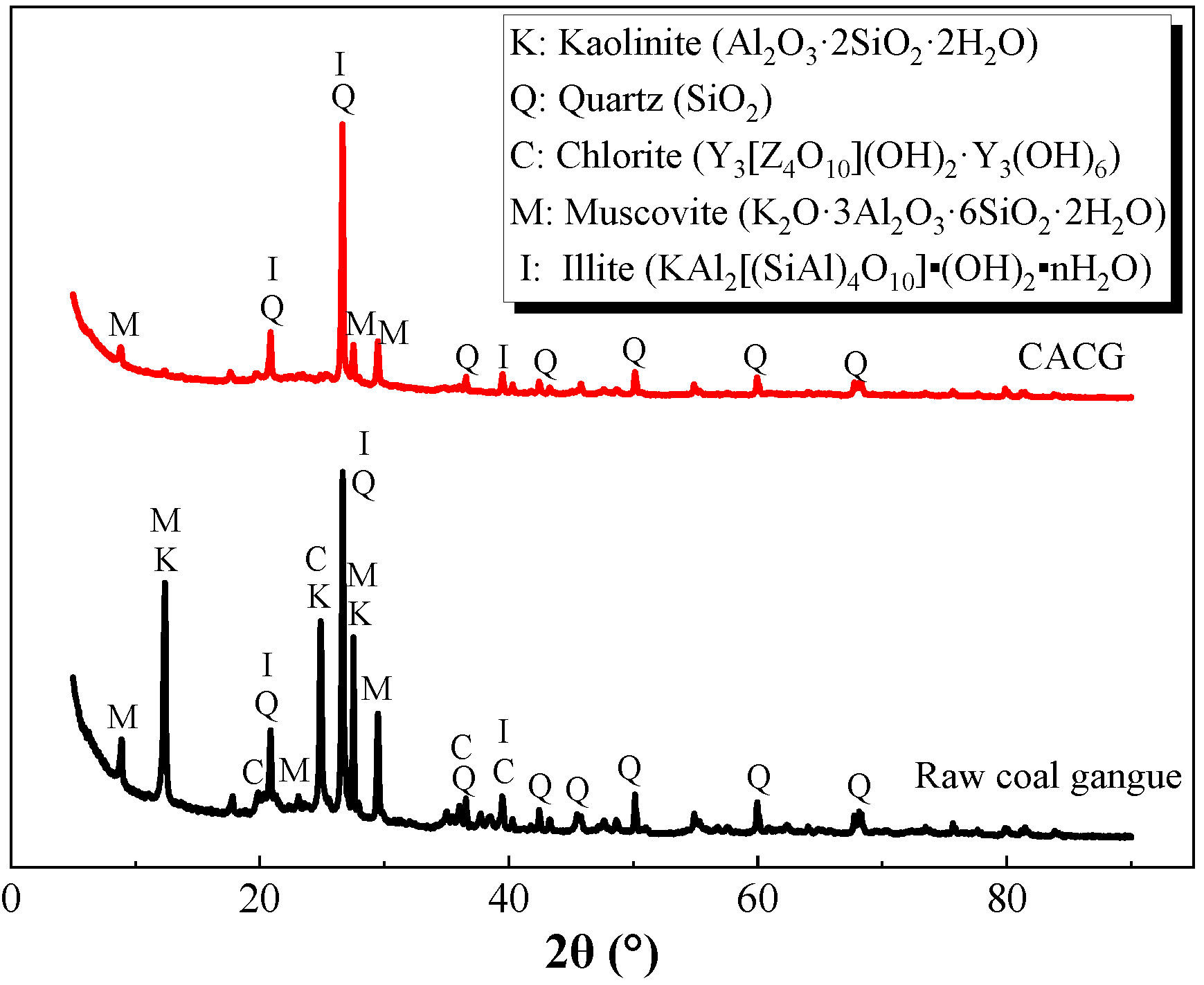
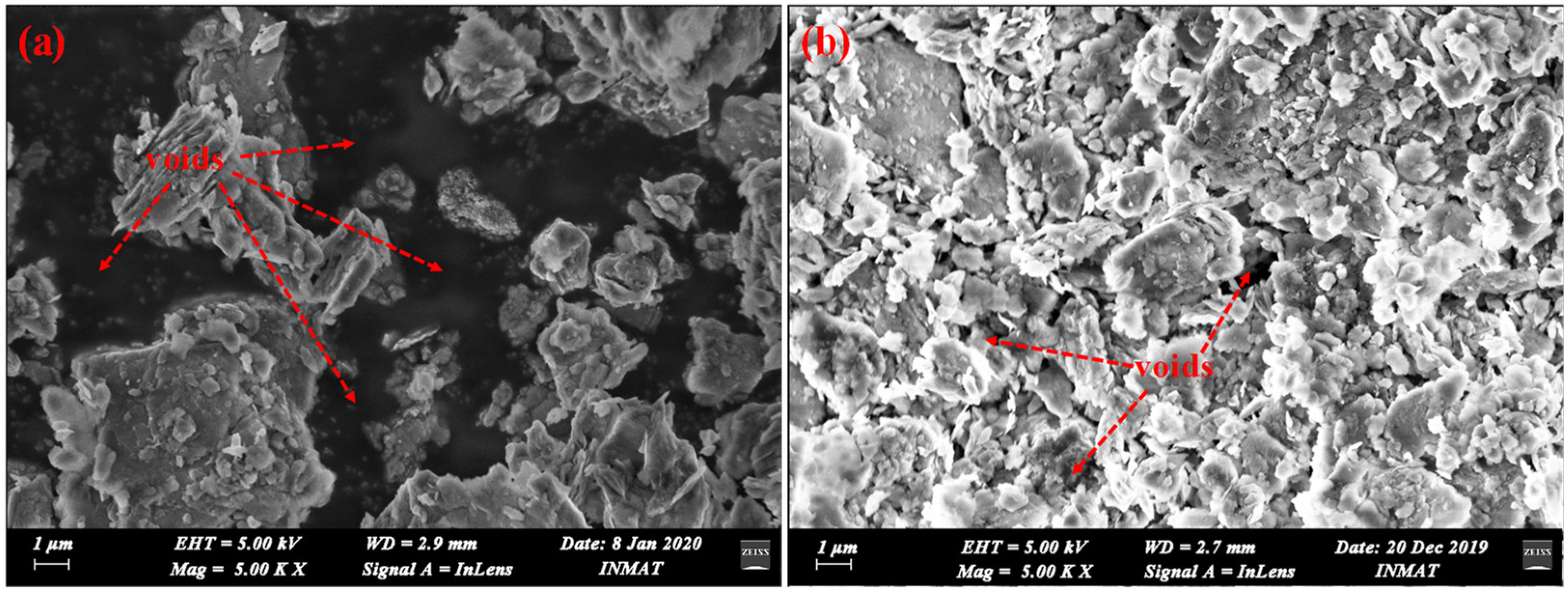
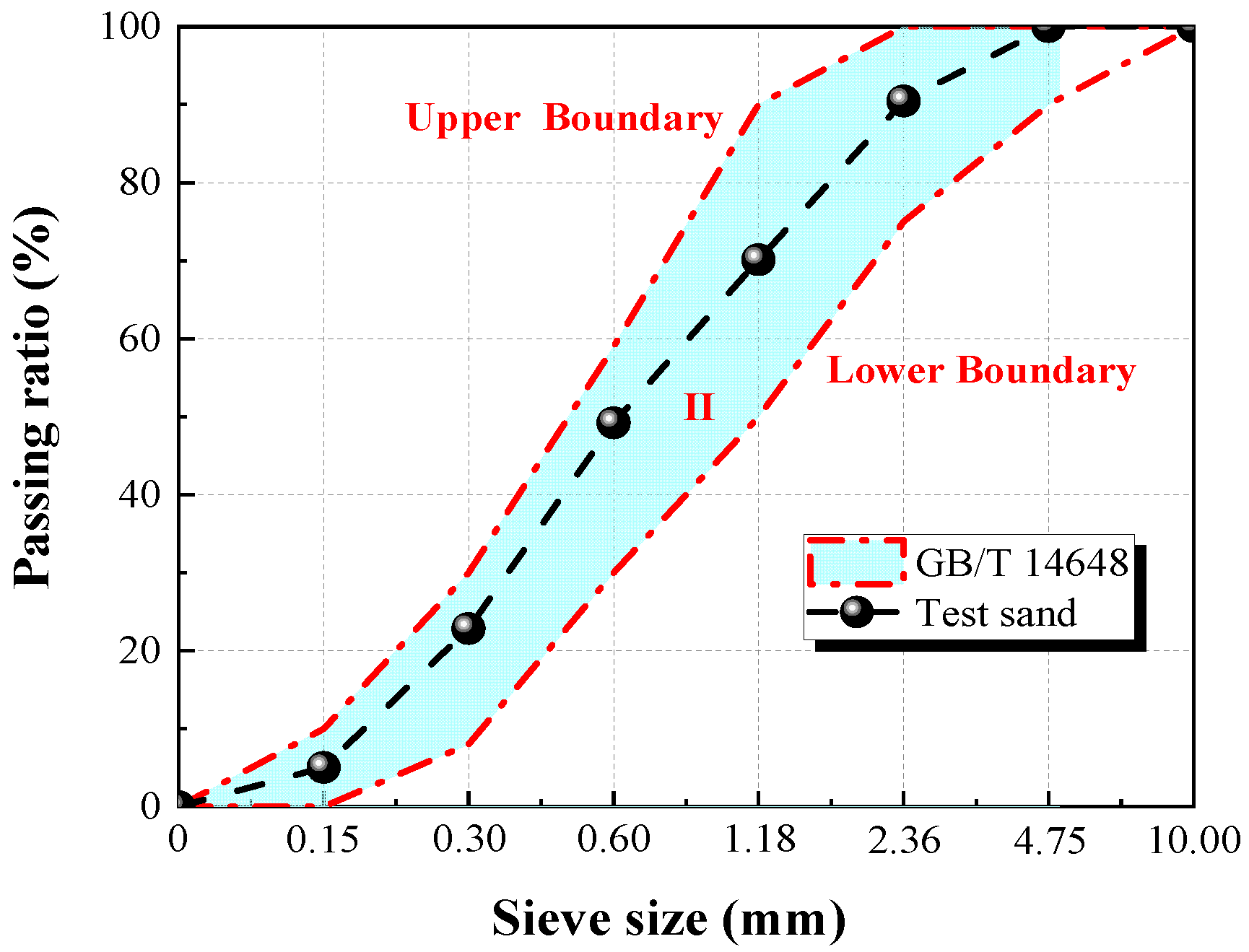

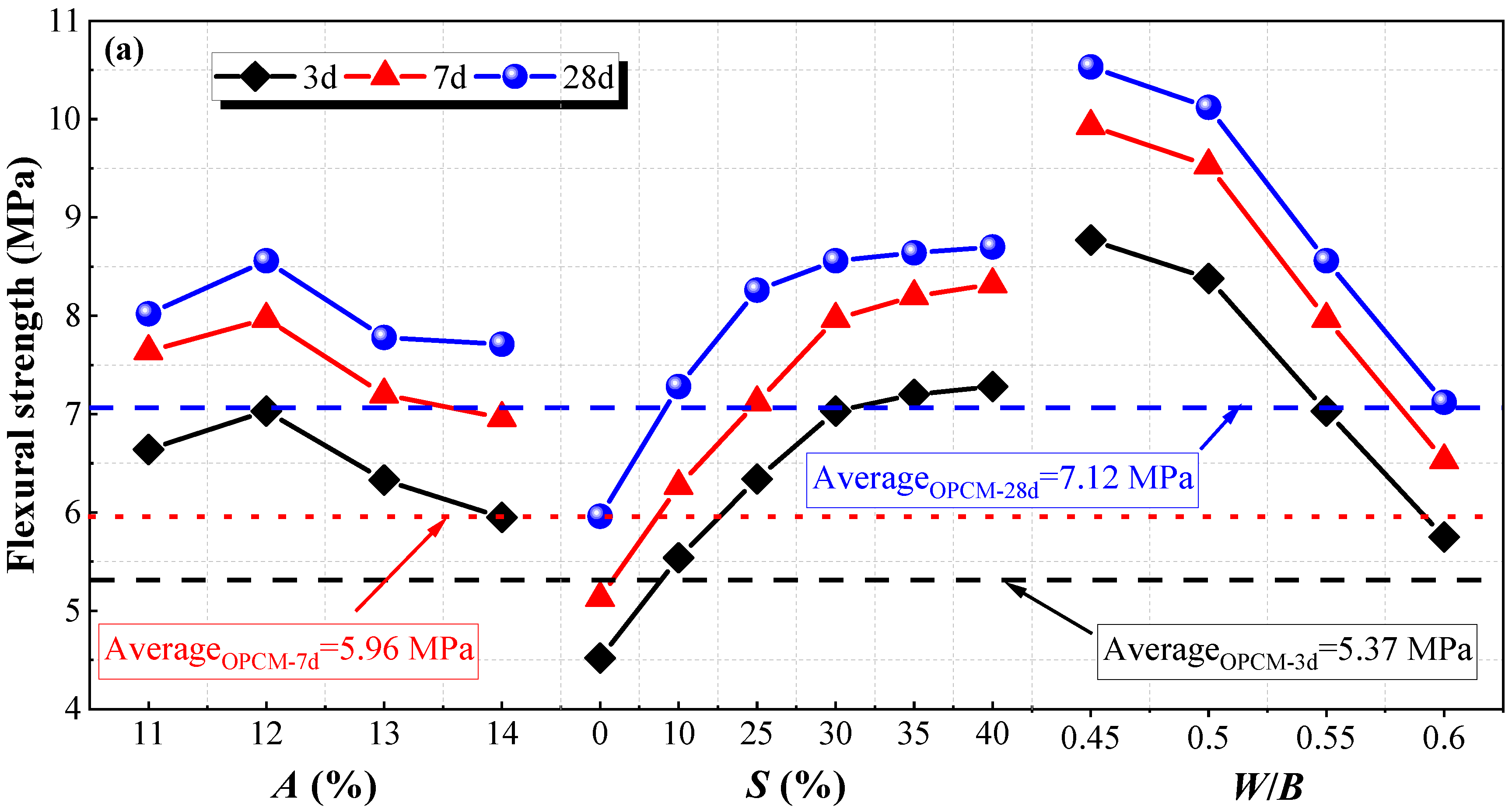
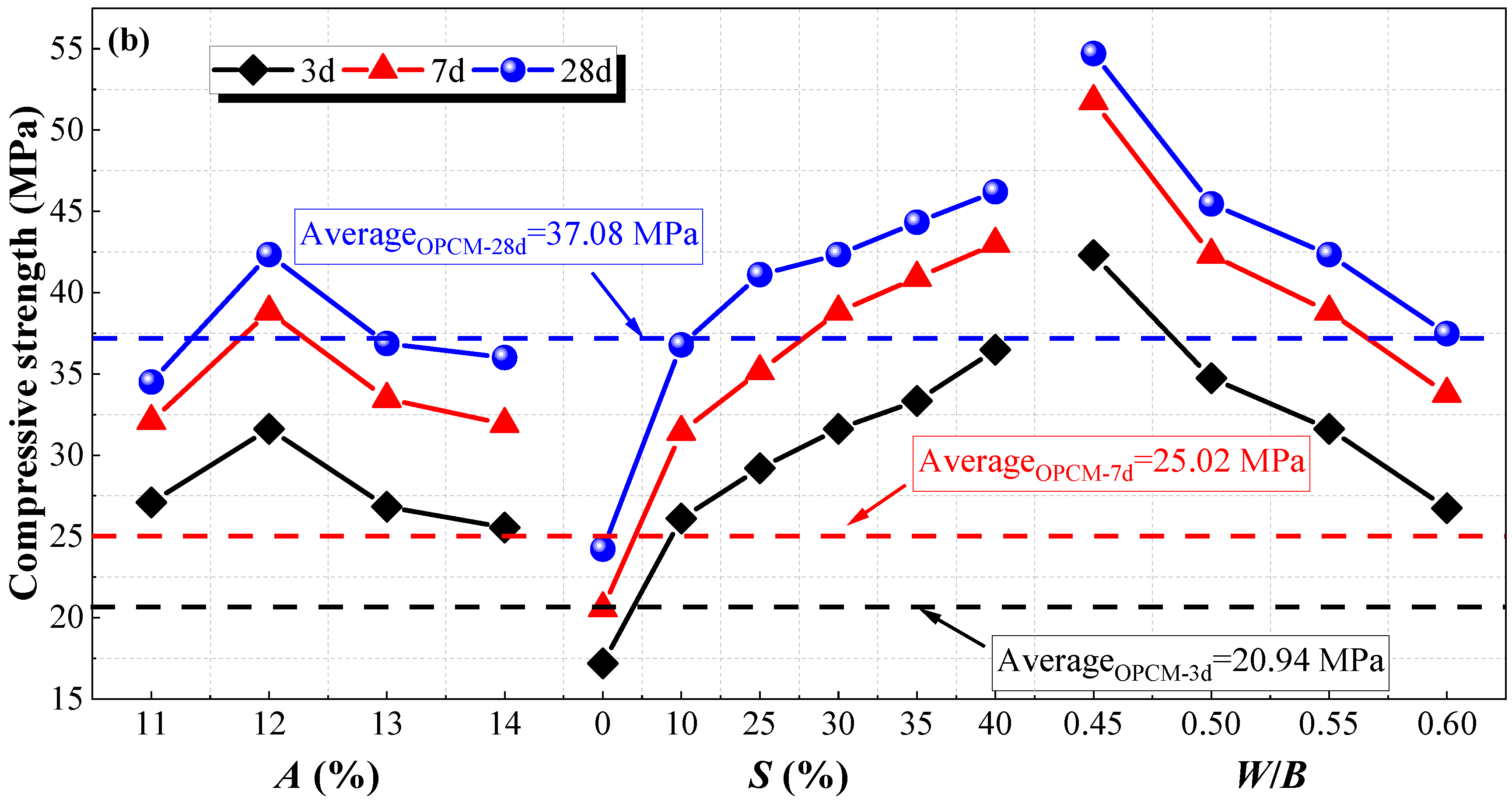
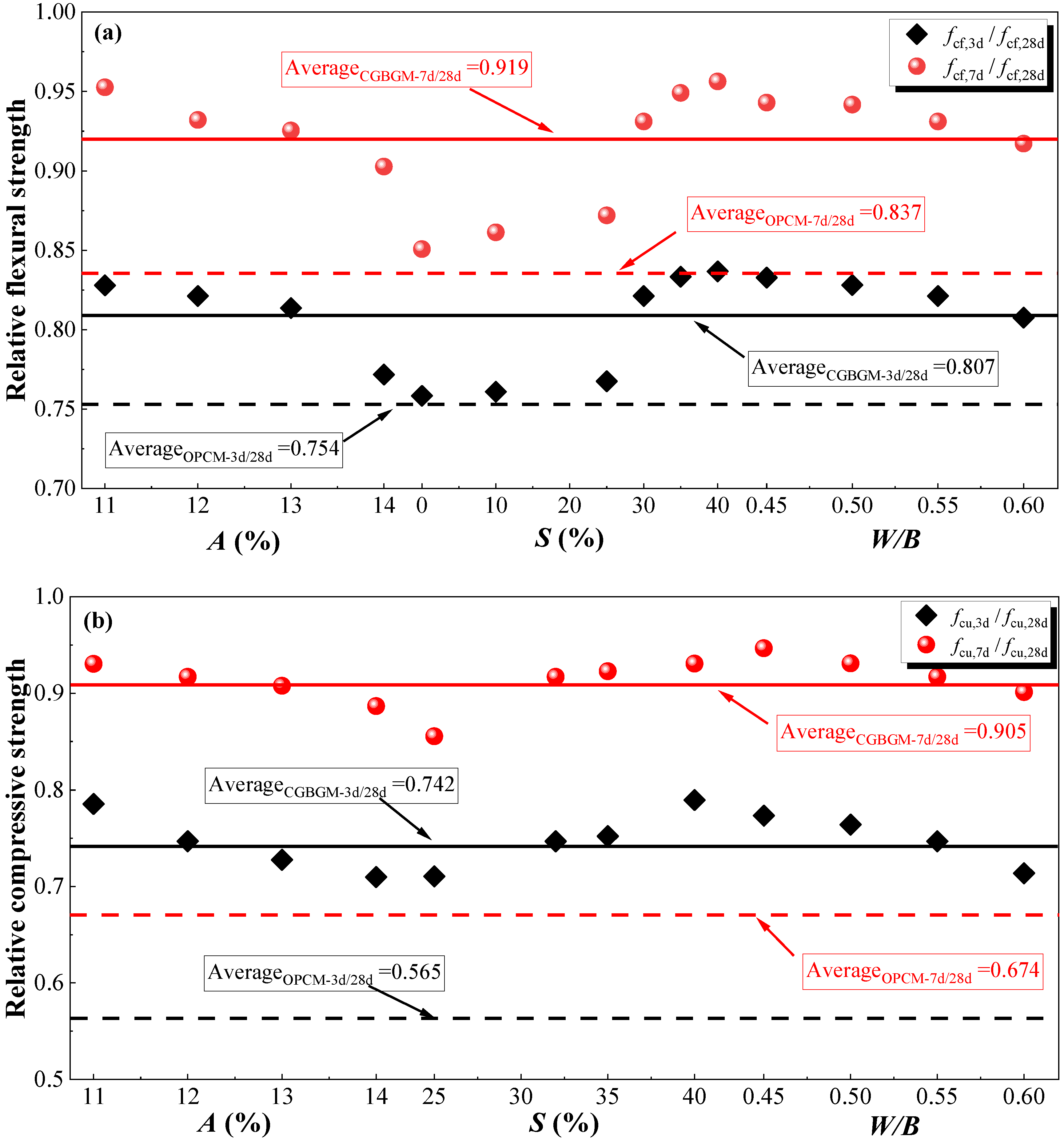


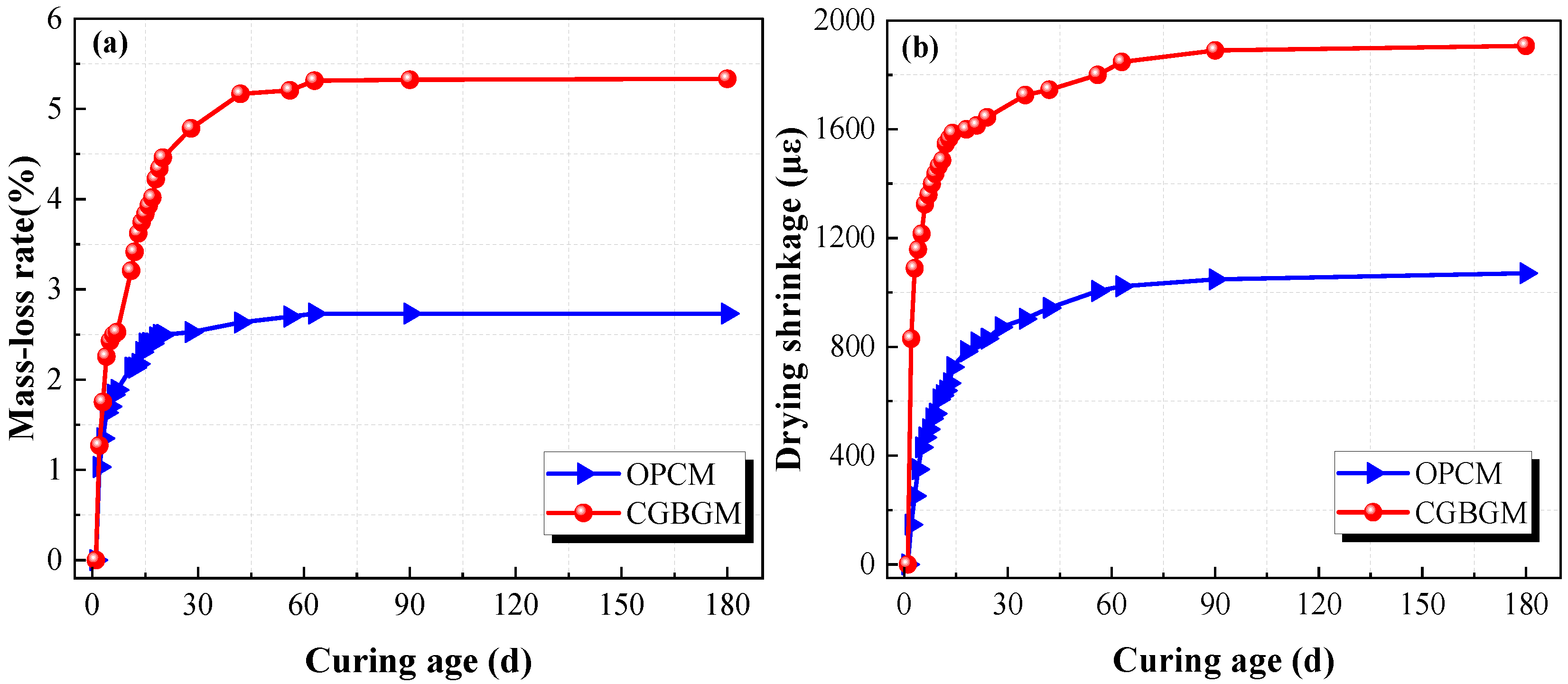
| Component | SiO2 | CaO | Al2O3 | MgO | Fe2O3 | SO3 | K2O | Na2O | LOI |
|---|---|---|---|---|---|---|---|---|---|
| Raw coal gangue | 55.14 | 0.41 | 40.96 | 0.30 | 1.23 | 0.43 | 0.20 | 0.09 | 15.33 |
| Slag | 36.10 | 35.58 | 16.32 | 11.32 | - | - | - | - | 2.30 |
| PO 42.5 | 21.08 | 60.20 | 7.10 | 2.11 | 60.20 | 3.85 | 1.16 | 0.214 | 2.1% |
| NO. | A/% | S% | W/B | CACG/g | Slag/g | Cement/g | Sand/g |
|---|---|---|---|---|---|---|---|
| A11 | 11 | 30 | 0.55 | 700 | 300 | - | 3000 |
| A12 | 12 | 30 | 0.55 | 700 | 300 | - | 3000 |
| A13 | 13 | 30 | 0.55 | 700 | 300 | - | 3000 |
| A14 | 14 | 30 | 0.55 | 700 | 300 | - | 3000 |
| S0 | 12 | 0 | 0.55 | 1000 | 0 | - | 3000 |
| S10 | 12 | 10 | 0.55 | 900 | 100 | - | 3000 |
| S25 | 12 | 25 | 0.55 | 700 | 250 | - | 3000 |
| S35 | 12 | 35 | 0.55 | 650 | 350 | - | 3000 |
| S40 | 12 | 40 | 0.55 | 600 | 400 | - | 3000 |
| W/B0.45 | 12 | 30 | 0.45 | 700 | 300 | - | 3000 |
| W/B0.50 | 12 | 30 | 0.50 | 700 | 300 | - | 3000 |
| W/B0.60 | 12 | 30 | 0.60 | 700 | 300 | - | 3000 |
| OPC | - | 0.50 | - | - | 1000 | 3000 |
| Criteria | Level of Significance |
|---|---|
| If F > F0.01 | Highly significant effect |
| If F0.01 > F > F0.05 | Significant effect |
| If F0.05 > F > F0.10 | Little effect |
| If F < F0.10 | Very little effect |
| Factor | Sum of Squares of Deviations | Degree of Freedom | Mean Square Deviation | F | Fx | Level of Significance |
|---|---|---|---|---|---|---|
| S | SA = 17.62 | 5 | 3.52 | 22.99 | F0.01(5,8) = 4.34 | Highly significant effect |
| SE = 1.84 | 12 | 0.15 | F0.05(3,8) = 2.81 | |||
| ST = 19.46 | 17 | - | F0.10(3,8) = 2.22 | |||
| A | SA = 21.89 | 3 | 7.30 | 6.80 | F0.01(3,8) = 27.49 | Little effect |
| SE = 8.58 | 8 | 1.07 | F0.05(3,8) = 8.84 | |||
| ST = 30.47 | 11 | - | F0.10(3,8) = 5.25 | |||
| W/B | SA = 1.34 | 3 | 0.45 | 3.62 | F0.01(3,8) = 27.49 | Little effect |
| SE = 0.99 | 8 | 0.12 | F0.05(3,8) = 8.84 | |||
| ST = 2.32 | 11 | - | F0.10(3,8) = 5.25 |
| Factor | Sum of Squares of Deviations | Degree of Freedom | Mean Square Deviation | F | Fx | Level of Significance |
|---|---|---|---|---|---|---|
| S | SA = 957.10 | 5 | 191.42 | 58.62 | F0.01(3,8) = 4.34 | Highly significant effect |
| SE = 39.19 | 12 | 3.27 | F0.05(3,8) = 2.81 | |||
| ST = 996.29 | 17 | - | F0.10(3,8) = 2.22 | |||
| A | SA = 473.78 | 3 | 157.93 | 33.54 | F0.01(3,8) = 27.49 | Highly significant effect |
| SE = 37.67 | 8 | 4.71 | F0.05(3,8) = 8.84 | |||
| ST = 511.45 | 11 | - | F0.10(3,8) = 5.25 | |||
| W/B | SA = 105.15 | 3 | 35.05 | 16.03 | F0.01(3,8) = 27.49 | Significant effect |
| SE = 17.49 | 8 | 2.19 | F0.05(3,8) = 8.84 | |||
| ST = 122.65 | 11 | - | F0.10(3,8) = 5.25 |
Publisher’s Note: MDPI stays neutral with regard to jurisdictional claims in published maps and institutional affiliations. |
© 2022 by the authors. Licensee MDPI, Basel, Switzerland. This article is an open access article distributed under the terms and conditions of the Creative Commons Attribution (CC BY) license (https://creativecommons.org/licenses/by/4.0/).
Share and Cite
Zhao, Y.; Yang, C.; Yan, C.; Yang, J.; Wu, Z. Design and Properties of Coal Gangue-Based Geopolymer Mortar. Buildings 2022, 12, 1932. https://doi.org/10.3390/buildings12111932
Zhao Y, Yang C, Yan C, Yang J, Wu Z. Design and Properties of Coal Gangue-Based Geopolymer Mortar. Buildings. 2022; 12(11):1932. https://doi.org/10.3390/buildings12111932
Chicago/Turabian StyleZhao, Yanbing, Caiqian Yang, Chengyu Yan, Jing Yang, and Zhiren Wu. 2022. "Design and Properties of Coal Gangue-Based Geopolymer Mortar" Buildings 12, no. 11: 1932. https://doi.org/10.3390/buildings12111932





